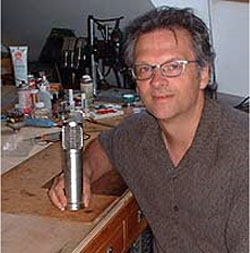
BB: What is involved in fine-tuning a new Brauner?
KH: With a Brauner, it’s down to capsule work. We had some tube problems at first, because even if you run it for two days, you can’t be sure. So now we run it five days. So fine tuning really means capsule work. First, you have to get the right capsule for the customer, like this one in South Africa, he says don’t give me anything that will bring out sibilants.
So I have to first find the one in the batch that is closest to what would be right, then I rework the diaphragms. Remember, there are mirror image systems in all large diaphragm condensers, front is identical to the rear—seemingly. So I would reverse them, and make what I call a front side selection. Which of the two sides on that preselected microphone would give me the better result?
Then I fine-tune the capsule, physically yank it out and using a torque screwdriver, adjust the distance from the diaphragm to the backplate and maybe even adjust the two backplates together. There are basically four parts to this sandwich: diaphragm, backplate, backplate, diaphragm. How these are put together determines midrange behavior, and also determines high and low frequency behavior.
So you have, within a certain range, some tolerance for discretionary adjustment. I can either tighten or slacken a little bit. Or I may take a diaphragm off and try another diaphragm, one with a different resonance frequency. I know from experience how a certain resonance frequency translates into upper midrange behavior.
BB: How do you know what that resonance frequency is?
KH: Very simple. I ping it. And I use a tuning fork. So if it sounds forward in the upper mids, and the resonance of the diaphragm is in the region of D sharp or E, I would say I could not do what I need to do by torquing the screws. I will need another diaphragm.
BB: That’s surprising! How broad is the range of resonance frequencies?
KH: It can be six or seven half tones, quite a bit. And you can’t control it much better than that. All of these go into ovens, that’s how they tension them. There’s still so much art, so much luck, in diaphragm manufacture. To a “t”, almost every capsule mimics something Neumann did in the late fifties. Look at any German or Chinese microphone, and you will find they all use the same basic principle.
But we have changed some of that with the Brauner. I never liked some of the phase shift you get with these capsules. For example, you speak into the front of the microphone, the sound hits the front diaphragm, but because it is a cardioid and it goes by addition and subtraction, you get it by rear entry as well, but the rear entry is time delayed. But there are ways to minimize this. Neumann made a beautiful capsule, with almost zero time delay, the M49 capsule and the U47 capsule. It was incredible. But they didn’t have high frequencies, it topped out at about 14kHz.
Even so, it had this wonderful relaxed, open, intimate thing that draws you in emotionally because it didn’t have phase shift. However, the 87 and 67 capsules have more sizzle, are more rock and roll, but they have more phase shift and are tiring over time. So Dirk had already invented something that I thought was genius, of how to combine the two issues. Then I went to work in the initial prototype stage, doing filing and drilling, testing, until we had it together.
BB: I’m still surprised that, after all these years and all the technology, that this hasn’t been reduced to some kind of exact science.
KH: Really, the question is, where do you take a machine with all this? Sure, with a TEF analyzer you can get a fancy graph, but what do you do with that information? It doesn’t get you anywhere as far as a useful tool. It doesn’t say, this is the situation and therefore you should do this and this. It doesn’t work that way.
It’s a question of discriminating listening, of dealing with complex waveforms. None of these analyzers really do well with complex waveforms. They are all one trick ponies. You give them a sine wave and they show what it does through the spectrum. But hit it with something that has sibilants and sine waves and noise all at the same time, well, forget it. You have to use your ears. Does that make any sense to you?
Yes, very much so. In fact it’s parallel to what I’ve heard over the past decade, when dealing with low resolution digital when compared to really good analog.
Oh, yes, the difference is dramatic. I went to Lucasfilm, to a scoring stage one time, and they were doing a small orchestra, and they were simultaneously running a Stellavox recorder at 30ips and a very sophisticated digital setup with Cello converters. We listened back and forth between inputs and outputs on both machines. The collapse of the hall, of the ambience, was so dramatic in the digital domain. The high complexity of that hall was reduced to a smidgen. There was practically nothing left but direct signal.
